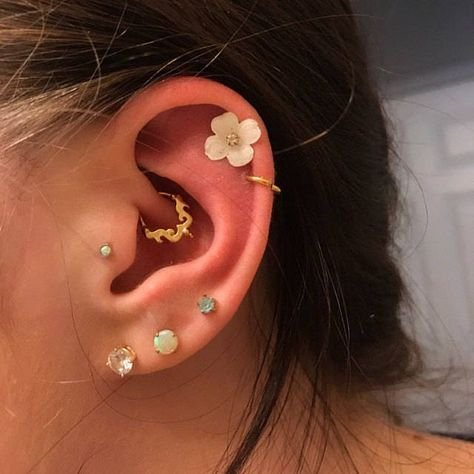A Comprehensive Guide to Cartilage Piercings
Updated: September 13, 2023
Cartilage piercings have been a symbol of individual expression for generations. From ancient tribal societies to modern urban landscapes, punctuating the cartilage offers a way for people to express their identity and adorn their bodies. For those considering this timeless art form, here's a comprehensive guide to understanding cartilage piercings.
Anatomy of Cartilage
Cartilage is a semi-rigid form of connective tissue found throughout the body. Within the realm of piercings, when we speak of 'cartilage,' we're primarily referring to parts of the ear and nose. Unlike lobes which are fleshy and soft, cartilage is more resilient and less vascular.
Types of Cartilage Piercings
Helix Piercing: Located on the upper outer rim of the ear.
Forward Helix Piercing: Located on the upper front of the ear, just above the tragus.
Industrial Piercing: Typically involves two piercings on the upper ear cartilage connected by a single piece of jewelry.
Daith Piercing: Located at the innermost fold of the cartilage.
Tragus Piercing: Done through the small piece of cartilage in front of the ear canal.
Conch Piercing: Can be inner or outer, and it’s placed in the large center area of the ear.
Rook Piercing: Located on the ridge between the outer and inner conch.
Snug Piercing: Located on the inner cartilage, near the outer rim.
The Piercing Procedure
Selection: Choose a reputable studio. Ensure that the studio follows strict hygiene standards and the piercer is experienced.
Marking: Your piercer will clean the area and mark the piercing spot. This gives you an idea of the placement.
Piercing: A sterilized needle is used to make the piercing. The jewelry is then inserted through the new hole.
Aftercare: The piercer will provide instructions for care to ensure the piercing heals properly.
Healing Time
Cartilage piercings generally take longer to heal than other body piercings. While lobe piercings may heal within 4-6 weeks, cartilage piercings can take anywhere from 3 months to a full year.
Aftercare Tips
Saline Solution: Clean the area twice daily using a saline solution.
Avoid Touching: Limit touching the new piercing to prevent introducing bacteria.
Pillowcase: Change your pillowcase regularly to keep the area clean.
Avoid Swimming: Refrain from swimming for at least a few weeks to avoid potential infections.
No Twisting: Do not twist or turn the jewelry as this can delay healing.
Potential Risks
Infection: Any piercing can get infected if not cared for properly.
Migration: Sometimes, the jewelry may move from its original place.
Keloids: A type of raised scar. Individuals prone to keloids should consult with a dermatologist before getting a cartilage piercing.
Bumps: Sometimes, small bumps can form around the piercing, which can be a result of trauma, irritation, or an allergic reaction.
Final Thoughts
Cartilage piercings are a beautiful way to accentuate the natural contours of the ear and express personal style. Armed with the right information, your cartilage piercing journey can be a smooth and enjoyable one. Always prioritize hygiene, choose an experienced piercer, and follow aftercare recommendations diligently. Happy piercing!
